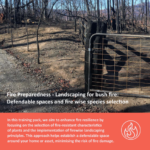Nature’s Answer to Fire: Nature-Based Solutions
Fires pose significant threats to landscapes, infrastructure, and individuals, and it’s important to understand and know how to mitigate the associated risks. Creating a defendable space is a key strategy in lowering the risk of bush fires to homes and assets. Employing nature-based solutions, such as selecting fire resilience species and employing fire-wise garden design principles, is vital for establishing a defendable space around your home or asset. These approaches are particularly crucial in fire-prone areas like Australia.
Australia has evolved its bush fire management by integrating Indigenous fire management practices, bush fire sciences, advanced technology, and community readiness. As part of the People Led Prevention Project, Landcare NSW wants to explore how nature-based solutions like plant selection and strategic landscaping can affect a home or property’s bush fire risk.
By integrating these nature-based approaches, we can better protect our homes, communities, biodiversity, and natural resources from the devastating impacts of fires.
How bush fires occur
To be able to effectively prevent and mitigate fires, it’s important to first understand exactly what causes them. bush fires are uncontrolled fires that occur in rural or bush areas, typically spreading rapidly and consuming vegetation, trees, and sometimes structures. These fires can be ignited by various natural and human factors including:
Natural Causes: Lightning strikes during thunderstorms ignite dry vegetation, especially in drought-prone or hot areas.
Human Activities: Discarded cigarettes, unattended campfires, and sparks from machinery and electric fences, alongside accidental ignition during outdoor activities or construction work, contribute to bush fire outbreaks.
Weather Conditions: Hot, dry weather and strong winds facilitate rapid fire spread, particularly in areas with dry vegetation.
Vegetation and Fuel Load: The type, density, and dryness of vegetation influence fire severity and spread, with dense vegetation and accumulated fuel loads increasing susceptibility to intense fires.
Climate Change: Higher temperatures, longer fire seasons, and more frequent extreme weather events worsen bush fire risks, amplifying their likelihood and severity.
Overall, bush fires are complex phenomena influenced by a combination of natural and human factors, with their frequency and intensity often influenced by climate, weather, and land management practices.
Knowing where to access information about warnings is crucial for effective bush fire preparation, enabling timely actions to protect lives, property, and the environment.
Risk Assessment, Planning and Compliance
Identifying high-risk areas and creating comprehensive risk mitigation plans are essential steps in preparing your property for fires. There are also building codes, vegetation management rules, and land use planning requirements. It’s important to consult with local fire authorities or councils for tailored advice and to ensure compliance with local regulations.
Problems/Impacts caused by uncontrolled bush fires on the natural environment
It must be noted that hazard reduction burns and bush fires differ significantly in their impact on vegetation and environmental health, with the former being controlled and aimed at minimising fuel loads to reduce wildfire intensity, while the latter often results in more extensive and severe damage to ecosystems.
Bush fires can have devastating effects on the environment while also impacting the economy and communities. Some impacts that bush fires have are:
Destruction of Vegetation
- Loss of native plant species.
- Damage to reforestation and revegetation projects.
- Destruction of wildlife habitats and food sources.
Soil Degradation
- Increased soil erosion due to the loss of ground cover.
- Reduction in soil fertility from the loss of organic matter.
- Soil structure damage, leading to compaction and reduced water infiltration.
Water Quality Deterioration
- Increased sedimentation in water bodies from runoff.
- Contamination of water supplies with ash and debris.
- Alteration of hydrological cycles and stream flows.
Loss of Biodiversity:
- Reduction in the population of endemic species.
- Disruption of ecological balances and food chains.
- Increased vulnerability to invasive species.
Downloadable Bush Fire Training Pack & Worksheets

Landscaping for Bush Fire: Defendable Spaces and Fire Wise Species Selection
In this training pack, we aim to enhance fire resilience by focusing on the selection of fire-resistant characteristics of plants and the implementation of firewise landscaping principles. This approach helps establish a defendable space around your home or asset, minimising the risk of fire damage.
Download: Fire Preparedness Training Pack

Help to Protect Your Home from Fire Risks
After learning about bush fire risks, it’s time to apply your knowledge and take proactive steps to protect your property.
Download: Fire Preparedness Worksheet
Bush Fire Videos
In this video we explore fire-wise plant ideas to help protect fire-prone areas. Discover the best fire-retardant plants, like fig trees and the endangered Magenta Lilly Pilly, that can help create a safer environment around your home. Learn how to build resilience on your property and understand the importance of canopy separation and non-volatile plants in reducing fire risks.
Other Disaster Resources
Information & Warning Systems
NSW State of the Environment – Fire
Bush fire Information Line: 1800 679 737